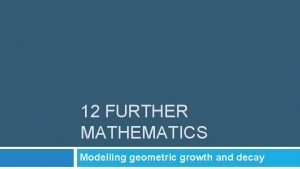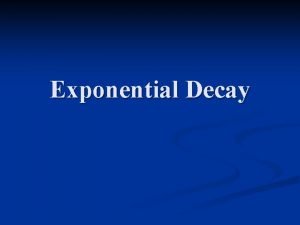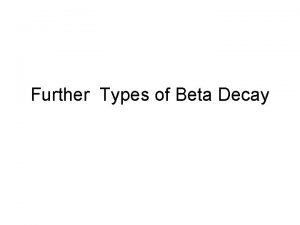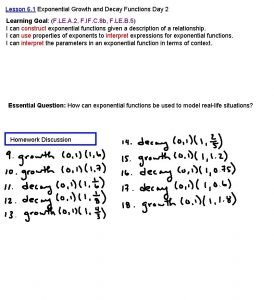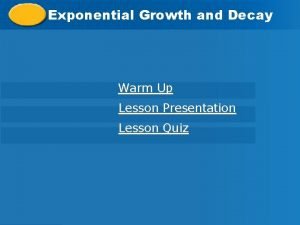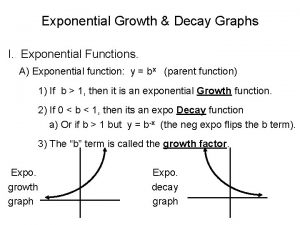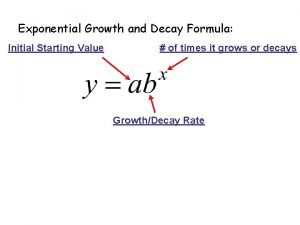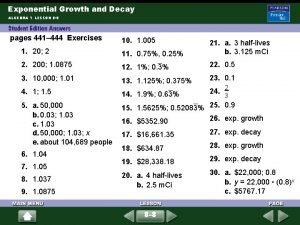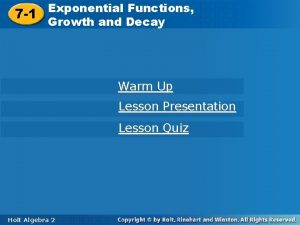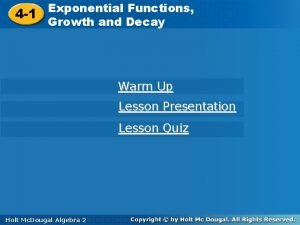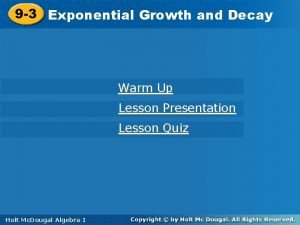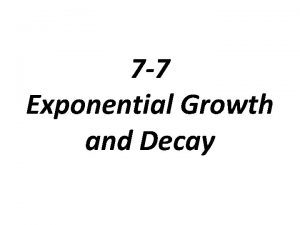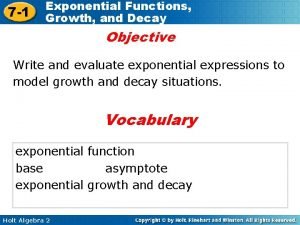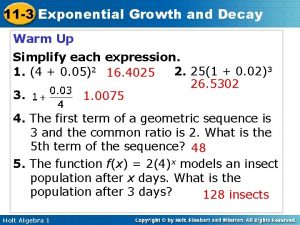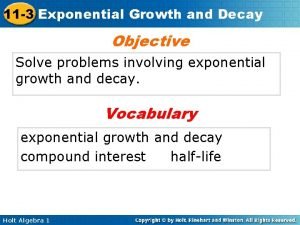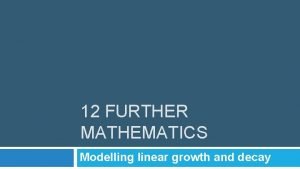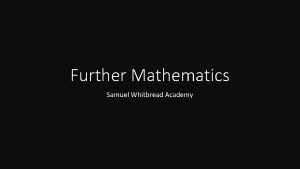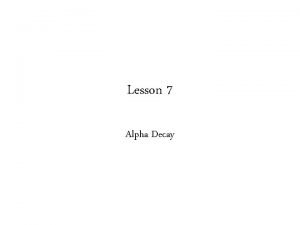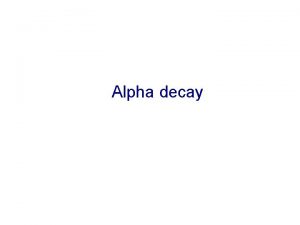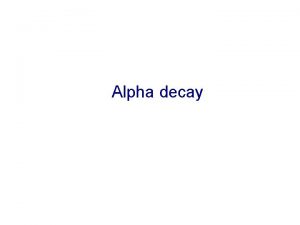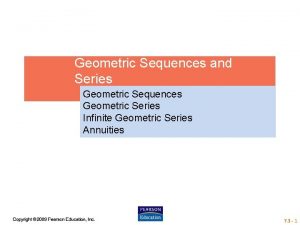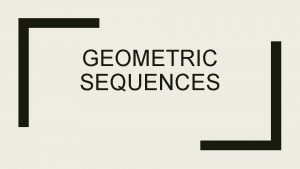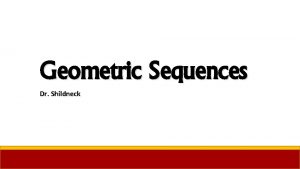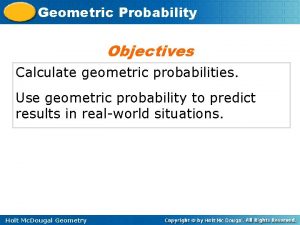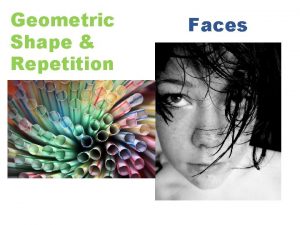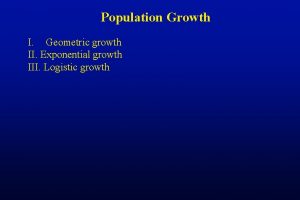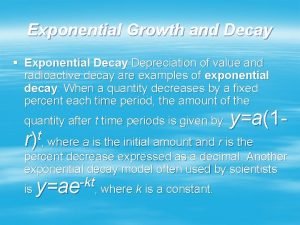12 FURTHER MATHEMATICS Modelling geometric growth and decay



















- Slides: 19

12 FURTHER MATHEMATICS Modelling geometric growth and decay

Modelling geometric growth and decay Like linear growth and decay, geometric growth and decay are seen commonly around the world. Everyday examples include the payment of compound interest or the depreciation of the value a new car by a constant percentage each year. This sort of depreciation is commonly called reducing balance depreciation.

Modelling geometric growth and decay A recurrence model for geometric growth and decay Geometric growth or decay in a sequence occurs when quantities increase or decrease by the same percentage at regular intervals. The recurrence relations V 0 = 1, Vn+1 = 3 Vn V 0 = 8, Vn+1 = 0. 5 Vn both have rules that generate a geometric pattern, as can be seen from the table below. The first generates a sequence whose successive terms grow geometrically, the second decay geometrically.

Modelling geometric growth and decay

Modelling geometric growth and decay As a general rule, if R is a constant, a recurrence relation rule of the form: �n+1 V = RVn for R > 1, can be used to model geometric growth. for R < 1, can be used to model geometric decay. We are now in a position to use this knowledge to model and investigate compound interest loans and investments, and reducing-balance depreciation, the topics of this section.

Modelling geometric growth and decay Compound interest investments and loans Most interest calculations are not as straightforward as simple interest. The more usual form of interest is compound interest where any interest that is earned after one time period is added to the principal and then contributes to the earning of interest in the next time period. This means that the value of the investment grows in every increasing amounts, or grows geometrically, instead of by the same amount as in simple interest.

Modelling geometric growth and decay Consider an investment of $5000 that pays 8% interest per annum, compounding yearly. This means that the investment’s value increases by 8% each year. We can model the investment with a recurrence relation as follows:

Modelling geometric growth and decay Let Vn be the value of the investment after n years. We can then write: V 0 = $2000 Each year, the investment will increase in value by 8%, so: value next year = this year’s value + interest earned or symbolically: Vn+1 = Vn + 0. 08 × Vn or more compactly: Vn+1 = 1. 08 Vn

Modelling geometric growth and decay We now have a recurrence rule that we can use to model and investigate the growth of investment over time. Unlike simple interest, compound interest loans or investments often accrue interest over periods less than a year and we need to take this into account when we formulate a general recurrence relation, as we have done below.

Modelling geometric growth and decay

Modelling geometric growth and decay

Modelling geometric growth and decay

Modelling geometric growth and decay

Modelling geometric growth and decay

Modelling geometric growth and decay Reducing-balance depreciation Earlier in the chapter, we studied two different methods for depreciating the value of an asset, both of which were examples of linear decay. Reducing-balance depreciation is another method of depreciation – one where the value of an asset decays geometrically. Each year, the value will be reduced by a percentage, r%, of the previous year’s value. The calculations are very similar to compounding interest, but with decay in value, rather than growth.

Modelling geometric growth and decay

Modelling geometric growth and decay

Modelling geometric growth and decay

WORK TO BE COMPLETED Exercise 8 E – All Questions
 Geometric growth and decay
Geometric growth and decay Geometric exponential growth
Geometric exponential growth What is decay factor
What is decay factor Geometric modelling in cad
Geometric modelling in cad Beta minus decay vs beta plus decay
Beta minus decay vs beta plus decay Growth and decay formula
Growth and decay formula Half life examples science
Half life examples science Exponential decay or growth
Exponential decay or growth Rate of growth or decay
Rate of growth or decay Practice 8-8 exponential growth and decay
Practice 8-8 exponential growth and decay Growth or decay exponential
Growth or decay exponential 7-1 exponential functions growth and decay
7-1 exponential functions growth and decay Exponential decay formula
Exponential decay formula Growth and decay formula
Growth and decay formula 9-3 exponential growth and decay
9-3 exponential growth and decay 7-7 exponential growth and decay
7-7 exponential growth and decay Growth and decay exponential functions
Growth and decay exponential functions 7-1 exponential functions growth and decay
7-1 exponential functions growth and decay What is the difference between growth and decay
What is the difference between growth and decay Exponential growth and decay formula
Exponential growth and decay formula
